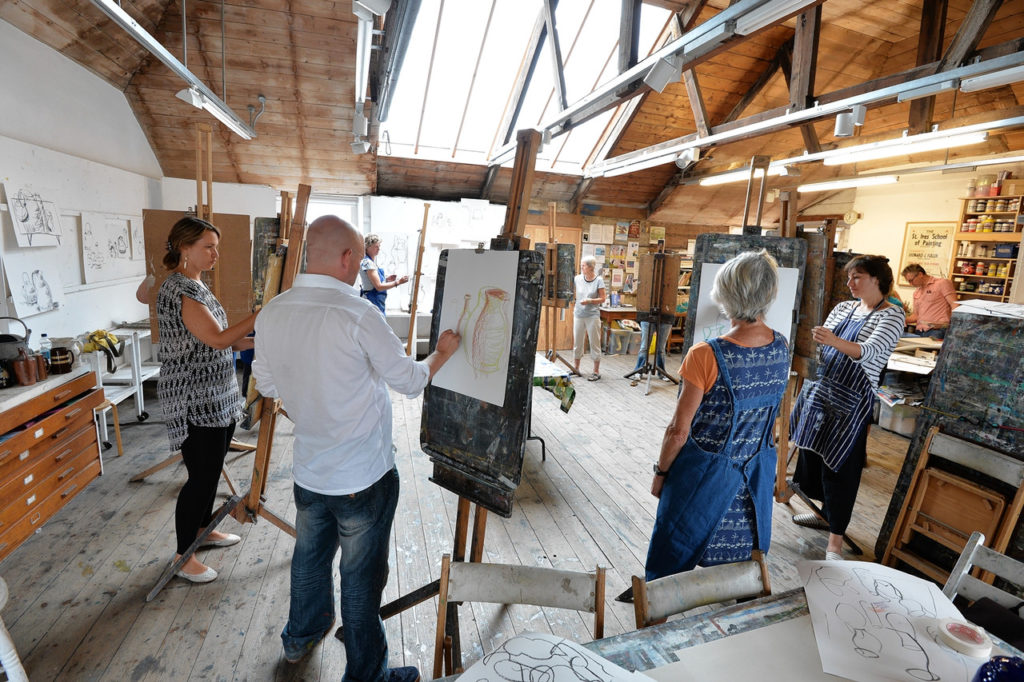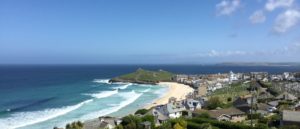The Wall Street Journal: A Brush With St. Ives
As seen in…

Anne-Marie Conway visits St Ives and joins us at the School of Painting to experience art lessons in Cornwall, in our stunning location above the beach during the quieter months.

“Tape the paper down on your clipboard, you don’t want it blowing away,” advised our tutor, Liz Luckwell, as she led us out of the St. Ives School of Painting down to the windswept beach. “Now, take a stick and walk across the sand and back, dragging it behind you. Then draw a section of the lines.” An unusual start to a painting course, I thought, chasing a sheet of rain-spattered paper after a botched changeover.
Even in the rain, this old fishing port is one of the prettiest towns in northwest Cornwall, on England’s southwest coast, and the luminous skies and ever-changing seascape have long brought artists here—most famously the sculptor Barbara Hepworth, who came with her painter husband, Ben Nicholson, in 1939 and never left.
Many had studios above fishermen’s cellars along Porthmeor Beach, a stunning bay perhaps best seen from the first floor of Tate St. Ives, the local outpost of the renowned London art museum. Knowing that the School of Painting was part of this studio complex was one reason my friend Karen and I jumped at a 2-for-1 deal on courses in November.
Come to St. Ives in high summer, and the narrow streets are noisy, the beaches crowded and the accommodation—
even in the old town’s single-bedroomed terraces—expensive. But in winter, there are deals to be had, most of the best restaurants stay open and you can eat fish and chips, cream teas and Cornish pasties to your heart’s content. And, thanks to the Gulf Stream, it’s generally warmer than the rest of the British Isles.
The St. Ives School of Painting, which opened in 1938, sits somewhere between a continuing education college and formal art school, and some courses—all taught by practicing artist-tutors—are only suitable for experienced painters. But “Exploring Form and Abstraction,” a five-day mixed-media workshop based on the work of three Modernists—Hepworth, the painter Wilhelmina Barns-Graham and the collagist Sandra Blow—sounded intriguing. And, I was assured, doable for a virtual beginner —but it was an intimidating group. Among us were veteran art teachers, professional artists and truly gifted amateurs, all seeking inspiration, time and space to make art.
Barns-Graham was our guiding spirit for the first day’s experiments in lines and mark-making. Willie, as she was known, had worked in a studio overlooking that very beach, producing distinctive abstract work grounded in natural and architectural forms.

The real achievement was stepping
–
back on the train to London with ideas to
keep me busy for years.
Like what you hear? You too can join us for an art course in our stunning studios in the heart of St Ives, Cornwall. With courses available all year round, you can pick a time of year that suits you. Browse all of our courses here.
10/3/2020
Share on
Related Stories

Your Monthly Roundup: July
A monthly round up of the latest news, insights and events. Sign up to our newsletter to receive this update straight to your inbox!

Restaurants & Beaches
With its rocky outcrops and golden crescents, St Ives’ peninsula is awash with beach options that rival any in the world, with world class surfing, powdery white sands, crystal water. Plus: some of the finest restaurants and cafés in Cornwall are just a stone’s throw away. Eating in St Ives Nestled in the town’s historic...

Inscape Outscape: A group exhibition
We are pleased to share an upcoming exhibition, ‘Inscape Outscape’. A collection of works by a group of contemporary artists who teach at the St Ives School of Painting. Made up of work from 18 artists, all with connections to St Ives and Cornwall, the exhibition will be open to the public from 10-17 December...
